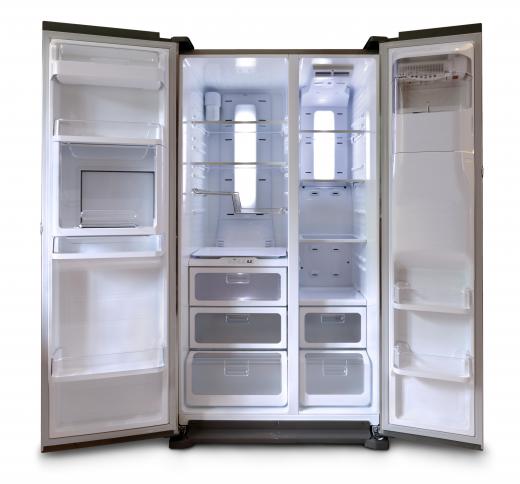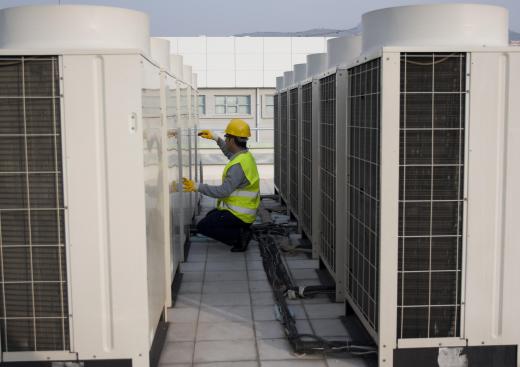An ammonia compressor is a mechanical device that creates refrigeration by removing heat from objects or spaces. Compression systems refrigerate by changing a refrigerant, such as ammonia, various types of Freon™, and other gases, from a liquid state to a gaseous state and back to liquid. Ammonia is commonly used in cold-storage plants, ice rinks, and other commercial applications. At one time, home refrigerators and freezers used ammonia but in modern times, domestic appliances normally use a type of Freon™.
Generally, a compressor compresses the ammonia gas, which heats up as it is pressurized. The hot, compressed vapors travel through coils — much like the ones on the back of a refrigerator — and dissipate the heat. As it cools in the coils, the gas condenses into a liquid that is still at a high pressure. This liquid flows through the expansion valve, which is similar to a small hole or port, into a low-pressure area. The drop in pressure causes the gas to immediately boil and vaporize, thereby dropping its temperature to -27° Fahrenheit (-32.8° Celsius), which creates the refrigeration effect.

An ammonia compressor may be one of three types: reciprocating, screw or helical, or scroll compressor. Reciprocating, or piston-type compressors, are generally similar to an automobile's engine system — the liquid enters the piston chamber and as the piston pushes on it, it is compressed into a vapor. In this style of compressor, the open compressor design is usually used for an ammonia compressor.

Screw, or helical rotary, compressors are either single-screw or twin-screw. Sometimes people refer to them as rotary compressors. Two gate rotors, or start gears, that intermesh with the screw not only drive the screw but also control and balance the load pressure. As ammonia enters the single-screw compressor, the screw turns and compresses it in the sections between the grooves and housing, and thereby forces the pressurized gas out through the discharge port and into the coil area.
A twin-screw ammonia compressor consists of precisely synchronized rotors that mesh closely when rotating within a shared housing. As a motor turns one screw clockwise, the other rotates counterclockwise. Generally, single-screw compressors with gate rotors are quieter and have less vibration.
Scroll compressors typically use one fixed and one orbiting scroll to compress the ammonia vapors. The stationary upper scroll contains the gas discharge port; the lower scroll's unique rotation causes the scroll to move in a circular path around the shaft's center. As it orbits, it gathers the ammonia vapors at the edge, thereby compressing it. The trapped vapors move to the center of the stationary scroll and exit through the discharge port.
In simplest terms, ammonia is a natural gas that is one part nitrogen and three parts hydrogen. Though ammonia is found in some common cleaning agents, it can be toxic, or even deadly, if misused. This is the reason that ammonia generally is not used in household refrigerators or freezers. Ammonia is used extensively in large, commercial chillers because it is less expensive to use. A home refrigerator with an ammonia compressor is typically an antique.
